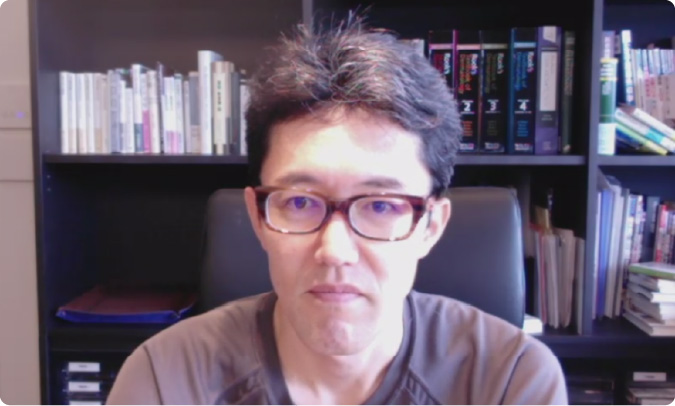Convention Case Studies
General Meeting of the Japanese Dermatological Association
Conference Overview
| Event Name | The 119th Annual Meeting of the Japanese Dermatological Association |
|---|---|
| Dates | May 4-7, 2020 |
| Location | Online |
| Attendance | - |
- <Contents>
-
- Professional Congress Organizer’s (PCO) perspective - Advice and learnings from Convention Linkage, the PCO who managed taking the event online for the first time
- Participant perspective - Interview with Japan Conference Ambassador, Professor Kenji Kabashima, Kyoto University, regarding the positives and negatives of switching to an online event
Taking a conference online for the first time - the PCO’s perspective

In June 2020, the Japanese Dermatological Association was scheduled to hold its 119th Annual General Meeting (AGM) in Kyoto. However, due to the Covid-19 pandemic, the entire conference was switched to an online format for the first time in the history of the event. How was it possible to successfully move this large-scale conference online? To find out, we spoke to Convention Linkage Co., Ltd., the PCO in charge of managing the event.
Tell us about the content and scale of the event.
The Japanese Dermatological Association’s AGM is an academic meeting attended by 5,000 to 6,000 people annually. In 2020, it was to be held at the Kyoto International Conference Center from June 4th to 7th. Under the theme of “connecting”, more than 100 sessions were planned, including sponsor sessions. However, due to the coronavirus pandemic, in April - just before the Golden Week holiday period - it was decided to move the 2020 AGM online. This left us with three weeks to make the preparations.
Was your company also in charge of managing past general meetings?
In the past, the secretariat of the Japanese Dermatological Association directed the overall operation of the AGM, but this time reached out to us to discuss taking it online. Since registering the trademark for “NetConvention®” in 2000, we have been conducting research, development and the execution of online conferences and webinars. For the Japanese Dermatological Association's 2020 AGM, approximately 80 accounts (IBM and Vimeo) were prepared and operated to simultaneously operate 12 tracks to run 180 sessions in total.
What kind of requests did you receive from the Japanese Dermatological Association for taking the meeting online?
First of all, they requested we maintain the format that had been planned to take place at the Kyoto International Conference Center and implement it as closely as possible online.
In addition, for seminars requiring the fair distribution of credits to attendees, it was mandatory to start on time.
For this reason, after considering the content and purpose of the seminars, they were then organized into three delivery methods:
- “On-time” format that is delivered once at a designated time during the AGM.
- “On-demand” format that allows you to watch as many times as you like during or after the session.
-A "live" format that enables two-way communication.
Luncheon seminars and evening seminars were also organized and held in these three formats.
Please let us know if you have any tips from your experience running this conference.
For credit-related seminars, participants need to be able to log in on time so that credit acquisition is not affected. For this reason, we provided a guide to the online conference and created an environment to enable people to test logging in a few days in advance.
Did the four-day operation go smoothly?
Even in real-life conference management, when participants move to a subcommittee after a keynote speech, it can take a considerable amount of time and the start is delayed. Similarly, in this online event, one session slightly ran overtime, and when the next session was scheduled to be delivered, we had people logging on to hear that one, concentrating access for a short time and overloading the server. By providing support so that participants could log in smoothly when the server recovered, we were able to operate without major problems.
Are there any other measures or points to consider that are unique to holding events online?
The event organizer must consider internet connectivity - it is essential to have a link that can be accessed stably and at high speed. The contracted line does not always have a constant capacity and speed 24 hours a day. Traffic can be crowded, especially in the evening. For this conference, as back-up, we prepared multiple lines and server tools. Even so, when it came time for the actual event, there were still times when it was difficult to connect.
Did the number of participants increase or decrease by holding the event online?
In general, the number of participants increases if the event is held online, rather than held in-person at a physical venue. This time too, there was an increase in the number of logins, compared to the number of participants in an average year. Therefore, when holding an online event, it is important to fully estimate and consider the access load to the server in advance.
How was the access from overseas?
There were participants from around the world. Japanese dermatologists (or skin specialists or doctors?) living overseas were watching, and international dermatologists (or skin specialists or doctors?) in other countries were watching sessions in English. In addition, overseas dermatologists who were originally scheduled to come to Japan as panelists participated online.
Two-way communication between the speaker and the participants, and also between the participants, is a very important factor in academic meetings. What kind of measures did you take to facilitate this online?
In each session, we adopted a setup that allows listeners to ask questions in a chat format. I think a certain level of two-way communication was achieved by taking the form in which the chairman who organizes the session selects questions from the audience, conveys them to the speakers, and proceeds while answering them.
Did you use social media?
The secretariat of the Japanese Dermatological Association opened a Twitter account for the annual general meeting and used it to share information with the participants. What was particularly effective was the tweet reporting, “the conference has become a very successful event with the number of people logging in to participate exceeding the number registered to attend the physical event.” We believe that it was a good stimulus for both speakers and participants, leading to a higher number of logins.

Did you have any rules regarding the shooting and recording of presentation materials?
Online it is difficult to completely ban screenshots and recordings. Therefore, on the viewer's login screen we included a column stating, "I agree to the condition of recordings and filming being prohibited." Login could not be completed unless the box to agree to this condition is checked.
What kind of feedback did you receive from the organizers and participants?
While other medical conferences due to be held at the same time were canceled or postponed, the AGM of the Japanese Dermatological Association went ahead online on the originally scheduled dates. The association put their trust in us and thanked us for delivering the event well, despite having less than one month to prepare. There was also a positive observation that participants who would not have bothered to physically visit the conference site, were able to participate due to the online format.
On the other hand, what was disappointing from the standpoint of both the organizer and us as the PCO was that we had many exchanges of opinions with each other about how best to realize the event online, but due to the time constraints, we had to stick with what could practically be activated in just three weeks.
What message would you give to organizers who will be hosting online meetings in the future?
The possibility of online events is greatly expanded if the organizer will openly consider the various ways they can be implemented. However, the preparation period and response differ greatly between a remote conference for a small number of people and the operation of a large-scale online conference, such as an academic conference.
In the case of large-scale online meetings, it needs to be understood that a high-level security environment is required to handle the vast amounts of personal data and to operate the conference safely, and it takes a considerable amount of time to prepare. It is also very important to clarify during the preparation stage the areas of responsibility for the PCO and which parts the organizer will take charge of independently.
Is the form of this online conference suitable for international conferences?
We have a track record of holding events in Asian countries, such as Japan, China, and South Korea, where the time difference is only minor. When adding Europe and the United States, it is necessary to devise a strategy to manage the time differences.
What do you think will be the format of future conferences for the likes of academic societies?
Through this experience, I think many people have noticed the good points of online meetings, such as being able to listen to multiple sessions using the on-demand function. At a ‘real-life’ event it would have been impossible for them to attend sessions that were on at the same time.
As the effects of the new coronavirus are expected to continue, we predict that for the foreseeable future there will be more hybrid meetings, combining ‘real-life’ meetings and online participation.
But even we admit, being able to actually meet and listen to the lectures of world-renowned experts is something that cannot be replicated online. Communication where people meet, exchange opinions and interact is still unique to in-person meetings. For the time being, I think the online format will be embraced, but I am convinced that the trend will not be a future of online-only events.
Participant interview: Japan Conference AmbassadorProfessor Kenji Kabashima, Department of Dermatology, Graduate School of Medicine, Kyoto University
Professor Kabashima participated in the 119th Annual General Meeting (AGM) of the Japanese Dermatological Association as a seminar lecturer and chairperson. As a notable expert in his field from a leading academic institution, Professor Kabashima was appointed a Japan Conference Ambassador by Japan National Tourism Organization in 2017.
Here we speak to him about his impressions of the online event.

How did you feel about participating in the online version of the Annual General Meeting?
Frankly, I felt that the way academic societies should be has changed. It is commendable that the number of participants in the AGM increased by holding it online. On the other hand, as a presentation lecturer and chairperson of online seminars at the event, I did experience some difficulties. In a real meeting, I adapt the content based on the audiences' age range and their reactions, but it is difficult to respond in such a way when held online.
What are the advantages and disadvantages of online meetings?
One of the methods of online meetings is on-demand delivery, which allows you to listen to other sessions that you could not attend due to a schedule clash. There are great merits to educational seminars at academic meetings going online, and I think they are best done online in the future.
On the other hand, a disadvantage is that there was almost no publication of new research results before the publication of papers. Also, unlike at real events, there were few forums where people could exchange opinions, so discussions on the academic field tended to be poor.
To facilitate two-way communication, we devised methods such as accepting questions in chat format from lecture listeners at seminars, etc. However, to protect the content of comments in chats, I think it would be a good idea to have participants register with their real name, instead of a handle name or nickname.
What is your opinion about the future of international conferences?
As mentioned above, there is no substitute for holding a live, in-person event in terms of presenting and discussing new research results. In an online event, it is not possible to meet and discuss face-to-face with prominent researchers from overseas, to build personal relationships with such researchers, and to improve Japan’s presence in the field of research through international relationships. I strongly feel that it is necessary to continue to hold in-person events related to the core of academic research.
For the time being, we think hybrid events will continue, but there is still room for improvement in responding to technical problems. In order not to damage the reputation of online events in Japan, it is important to share know-how throughout Japan, regardless of the conference field, to make things run as smoothly as possible.

